Sequels always have it rough. If they change to much they risk losing their original audience. Yet if they change to little then their old audience could grow bored. Sequels to established properties have it even worse as the story is already set out before them. If they change that then fans will get upset, yet more often than not this original work isn’t paced or planned for an episodic anime format. It is this trap, this catch 22, that the subject of this review falls into. Now produced by Studio Brain’s Base, originally written by Hasekura Isuna and once again directed by Takeo Takahashi I give to you Spice and Wolf Season 2. Now with 100% more animation! So without further ado lets talk about economics and fox-eared waifu’s!
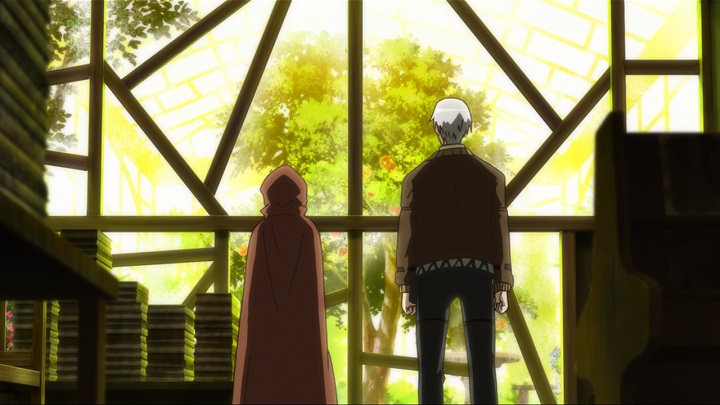
Visuals
Like usual I find that the best place to start when talking about anime is with the animation and visuals. And it is here that Spice and Wolf makes the greatest improvement. As I said in my review of Season 1, Spice and Wolf’s animation was not terrible, though only because it was rarely animated to begin with. And while the overall direction and shot composition tried to make up for that, no one watched the first season for its production. That is no longer the case in Season 2. With the production being shifted to Studio Brain’s Base, currently making To Your Eternity, Spice and Wolf looks better than ever. From animation to backgrounds, everything has improved.
Starting with animation, the characters actually move now! Where once Holo and Lawrence would be static figures in a conversation now they have charming gestures and shifting facial expressions. They are able to interact with the environment, and each other, more than ever before! From Holo stroking her tail in conversation or bouncing off of Lawrence or getting absolutely shitfaced to Lawrence and others walking, talking and gesturing all in a single scene, the changes are obvious. To detractors, sure, you won’t find any big setpiece moments in Spice and Wolf. There won’t be any Yutapon cubes or Itano Circus’, this is true. But you’re also watching a romance about micro-economics so if you came into it’s second season expecting that I think that’s on you. Suffice to say Spice and Wolf has improved dramatically in its subtle motion and character animation.
Meanwhile on the backgrounds I can happily report that they’re just as good as the first season! Art Director Toshihiro Kohama returns for this season and he hasn’t let up in the slightest. The backgrounds are still beautifully detailed and the colors absolutely pop. All the while never allowing the characters to blend or disappear into them. Kohama even managed to keep a similar level of variety to the first season despite having much fewer locations at his disposal. This is because the narrative, which we will discuss later, takes place in the same two cities across Spice and Wolf’s entire 12 episode cour. Yet despite this we still get bright greens and yellows, somber blues and passionate reds. Somehow fitting all of these colors into the same location without breaking our immersion in said location. What I’m saying is that Toshihiro Kohama has done good work, again.
Speaking of good work I couldn’t end this section without talking about Takeo Takahashi and his team of story boarders. Their work, the way they compose and block out shots, is a large part of what makes Spice and Wolf work. They take scenes as simple as walking through a town and turn it into a winding path with many different branches and possible outcomes. Matching the scene and characters actions to their conversation, such as mirroring characters movements in puddles or presenting obstacles to fit their moods and subject of conversation. Considering how much of Spice and Wolf is walking, talking and scenery this helps to alleviate some of the boredom you might feel in the long stretches between things happening.
That’s right, that’s my segue into talking about the narrative. Lets go!

Narrative
If you enjoyed the narrative of Spice and Wolf’s first season then I suspect you will also enjoy the second. The same basic story, the thematic core, is still there. This is still a slow burn romance between two mature, adult characters. Something that’s actually rather difficult to find among modern anime if you ask me. However it’s in that description that the problems begin to arise, specifically the “slow burn” part. In season one of Spice and Wolf the relationship between Holo and Lawrence was still new. Any progress was a major step and very noticeable to the audience. So what then is my problem with this, the second season? If the the characters are still good, which we will talk about, and the core of the story is there what could go wrong? Well simply put, I think its to slow.
Indeed, across the various arcs of season one our two leads go from complete strangers to affable traveling companions. Yet it feels like it takes the entirety of season 2 for Holo and Lawrence to move beyond that. On its own this isn’t a big deal. 12 episodes to move past “friends” doesn’t sound so bad when compared to most romances. However the problem is in its execution. This season of Spice and Wolf is split into 2 major arcs. But while side characters and events may change between arcs the core conflict between Holo and Lawrence stays the same. It’s as if Spice and Wolf repeated similar relationship woes across both but only bothered to give us a real conclusion, real progress, in the last 5 minutes of the final episode. Don’t believe me? Lets talk specifics.
Click here to read spoilers about Spice and Wolf season 2.
In the first arc of this season we see Holo and Lawrence begin to question what they are to each other. Are they lovers? Traveling companions? Client and merchant? Neither of them are sure and during this confusion Holo has a bit of a panic attack about their future and runs while Lawrence spends the rest of the arc trying to win her back and come to terms with his feelings for her. Meanwhile in the second arc our leads seem a lot more comfortable with each other. They are blatantly flirting and its good times all around. But as the arc goes on we see a lot of the same conflicts, just presented in a less explosive manner. They still aren’t fully sure what they are. They are still afraid of taking that step, etc etc.
One could argue that these are two separate issues. That I am being to harsh and that the first arc is about recognizing those feelings while the second is about admitting them. About truly accepting that they are a couple. And if that jives for you, if that’s how you interpret and experienced those arcs, then fantastic! Don’t let me tell you how to enjoy media! But for me these two arcs felt agonizingly slow. The constant back and forth between Holo and Lawrence, while witty and entertaining in the moment, started to feel like empty space by the end. Like Spice and Wolf was just packing time until the finale. It’s clear to me that these two arcs were simply not long enough to fill 12 whole episodes, though no doubt the finale we got was the easiest place to end the series knowing how many light novels exist.
This was also compounded by the sheer amount of flashbacks this season has. I get it Spice and Wolf, you want me to remember the events that lead up to here and the emotional journey the two went through. But how many times do I have to see the same few flashbacks across a 12 episode season? Do you not have any faith in your viewers to remember these events, to be invested in your story? Whatever the reason for their inclusion, these flashbacks slow down the narratives pacing tremendously. These two arcs could probably have fit into 10, maybe 9 episodes, yet these flashbacks extend them out to a full cour and really stretch them thin. And I think that more than anything is why season 2’s narrative fell short for me compared to season 1’s.
All that said, my complaining aside, I did still enjoy the core content. It felt stretched, it felt thin, I felt beat over the head with it, but I do still remember parts of it fondly. Holo and Lawrence’s cute back and forth, the festival, the conversations. If all you want is to see Holo and Lawrence banter with each other than this season will deliver. I just wish it delivered a bit faster is all.
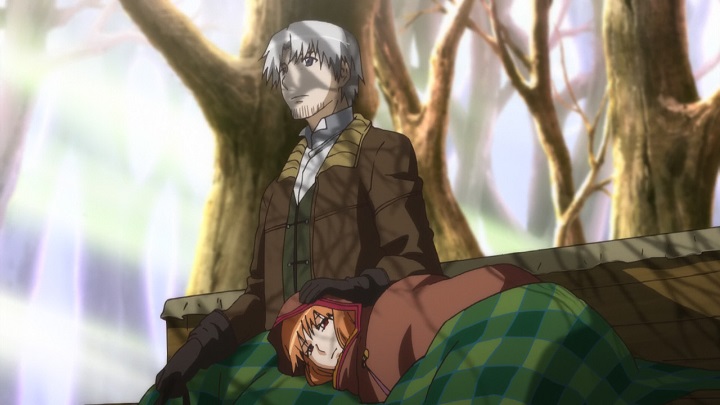
Characters
This brings me to the characters. If you’re reading this review then odds are you have already seen season 1 and that you already know how good Holo and Lawrence are. The way they play off of each other, how their personalities feed into one another, etc. It is not an exaggeration to say that these two leads are the main appeal of Spice and Wolf. That hasn’t changed in this second season. All the quips, all the flirting, the back and forth with subtext about their relationship for the sharp eared viewer to pick up on. All of that is just as good as before. When the pacing of the main narrative got slow and everything started to drag, their dialogue is what kept me engaged. While our leads are still as great as always though there is one area Spice and Wolf majorly improved in: Side characters.
To put it simply, the side characters in this season stand head and shoulders above the first. No doubt part of this has to do with the slower pacing that I so furiously attacked earlier in this review. The longer time spent in each arc, each city, allowed these characters more time to develop. In season 1 we might only see Zheren, Weiz or Chloe for 1 or 2 episodes. But in season 2 Marc, Batos and Fermi are constants. This however is still unfair to how well written these characters are. While they have more screen time that time is also used much more effectively.
Lets take Marc for example. Much like Weiz from season 1, Marc is a friend and business associate of Lawrence who appears in the first arc. We very quickly learn a lot about Marc: He runs a stall, has a family and is a respected member of the community. All standard stuff. But over the course the arc as Lawrence gets in trouble, as Lawrence does, we start to see what those things mean to him. That he can’t sacrifice his reputation in town as a static merchant the same way a traveling one like Lawrence can. That a big risk-it-all venture isn’t the same for a man with a family as it is for one without. We see that despite being Lawrence’s friend, a very good one, Marc isn’t a pushover or a convenient plot tool. He’s real man with his own concerns and considerations and I love it.
This isn’t to say that all of this seasons cast are standouts. Rigolo existed for all of 1 scene while Eve needed some more time in the oven. Not everyone is perfect. But by and large I remember the cast of this season more fondly than I do most. From Batos to Fermi, Marc to Dian, most of the important members were well realized and engaging in their own right. They had lives and ambitions beyond our characters. Reasons for the things they do/did. And I think that’s pretty damn cool.
Audio
Last but not least we have the audio where I talk about sound effects and OST! And once again not much has really changed from the first season. Despite the production moving over to Studio Brain’s Base much of the staff is still the same. Yukako Inoue is still the Music Producer and Hajime Takakuwa the Sound Director. Together these two are, by and large, responsible for how Spice and Wolf sounds. And just like the first season, it sounds alright. While there isn’t anything stand out here, no particularly unique ambience to draw you into the space, there also isn’t anything to take you out of the space either. Feet striking stone, mugs clattering and wagon wheels rolling along all sound like they should. Yet despite this decidedly average showing I quite enjoyed how Spice and Wolf sounded. And that comes down to the return of Yuuji Yoshino’s music.
I really, really like Yoshino’s work on Spice and Wolf. Some might argue that this is just more of the same. That there isn’t really anything different about this OST from season 1. And if I’m being frank, they would be correct. This season’s music does sound very similar to first. Just like the 1st season, this music is once again split into 3 main groups: Travel, Tradition and Action. The Travel music is what you think, the ambient sounds of civilization. From the structured dance of “Houjou no Waltz” or the energetic festival of “Shukusai no Hajimari” to the soft and cheery everyday sound of “Hoshita Sakana to Budoushu to“. This pieces in this section are categorized by the number and complexity of the instruments present and how work together, much like the towns they portray.
This brings me to what I call the Tradition section of Spice and Wolf’s music. These are pieces defined by their simplicity. Often using only a single instrument, or class of instrument such as strings in “Umaranai Mizo“, across the entire piece. They are slow and plodding works that are unbothered by the hustle and bustle of the city life. Moving at their own pace such as in “Hito to Ikyou no Kamigami“, a 6 minute piece pairing strings, vocals and drums into an almost exploratory piece as it travels deeper and deeper into the lands untouched by man. We see this motif revisited in the haunting “Rakuen Soushitsu“. It completely abandons manmade instruments, even lacking the structure brought by words, instead focusing entirely on the human voice and its range. These songs may not be complex, highly active works but that does not make them any lesser.
Finally this brings me to what is once again the smallest, but certainly not quietist, section of music: Action. Spice and Wolf is not what I would call a very active show. The characters are rarely running anywhere and combat is never the focus with most conflict being about outwitting someone rather than beating them up. As such the music in this section is much more about tension than it is action. Take a listen to “Boudou” for example. It uses shrill and sudden strings off-pace with each other to drive home the feeling that something is wrong. Ramping up in intensity as the song goes on. Or “Kurai Takurami Itsuwari no Torihiki” which starts off slow and quiet, its strings once again fighting each other for dominance before quieting down and exploding into action. This is how Spice and Wolf drives conflict.
So yeah all in all I liked Spice and Wolf’s OST. I don’t mind that it’s similar to the 1st season because I liked the 1st season. I like Yoshino’s work here. How he uses specific instruments to capture the feeling of the time period or his use of motifs and how he structures the music to make it feel more or less civilized based on the location or mood *Spice and Wolf wants us to feel. It’s quite nice! If that’s not the case for you, if you found the 1st season’s OST to be boring, then this won’t change your mind. But for fans of the original I can’t help but call this a success.

Pitfalls of Partial Adaptations
This brings me to the personal section of this review. This has absolutely no bearing on the score and is just me trying to connect with you. To tell you about what really resonated about Spice and Wolf for me, spoilers and all, without any burden to “review”. If you don’t care about that or don’t want to read spoilers then move on! But if you’re interested? Then lets talk. (Click to reveal).
So… What happened to this season? Why didn’t I like it as much? I touched on the basics in the narrative section above. How the pacing is off and individual character progression felt a lot smaller. But I want to take this opportunity to talk about why I think it happened and how, if at all, Spice and Wolf could have avoided it. And the answer to both of those questions lays in the title of this section: Partial adaptations.
What do I mean by partial? Well, to give air to the obvious, Spice and Wolf is adapted from a Light Novel series of considerable length. I think there’s 22 of the original series with another 5 of the sequel? With the anime adapting volumes 1 through 5 and skipping volume 4, according to a good friend of mine. That’s a lot of content to adapt! And so the question becomes: What do they adapt and how much? What is the best, most conclusive stopping point when they don’t know if they will ever get a third season? How do they take a series that was clearly not written with an anime’s pacing in mind and adapt it for the 1 cour format? These are all things that non-original series have to take into consideration. From modern Shounen like One Piece and My Hero Academia down to this.
Now in Spice and Wolf’s case I think they did the best with what they had. The ending does feel conclusive. Like the characters have gotten closure and really figured themselves out. Obviously there is more content to go exploring that relationship but this feels like a good stopping point. But the tradeoff to choosing a stopping point and fitting the content to the cour vs fitting the pacing and arriving at a stopping point naturally is exactly as I’ve described. And while I don’t like the result I honestly I can’t think of how they could have done it better. Had they sacrificed the conclusive ending for a mid-arc cliffhanger or another “will they wont they” finale I imagine that would be far more damaging. So while I don’t like what Spice and Wolf did to its pacing I can at least understand why they did it.
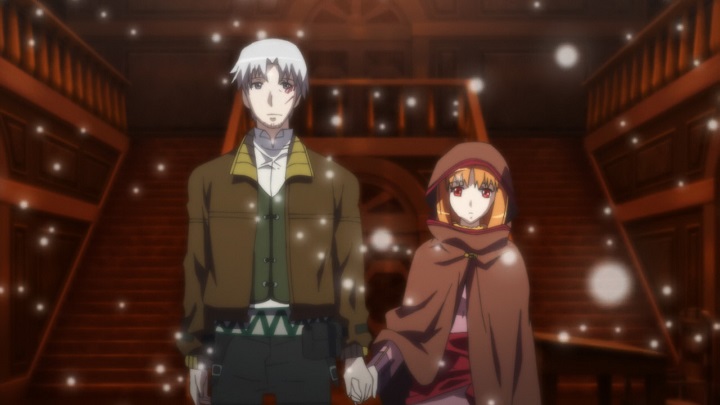
Conclusion
This begs the final question: When all is said and done and considered, what did I think of Spice and Wolf Season 1? And the simplest answer I can give is that I enjoyed it, but not as much as season 1. While the visuals have improved tremendously and the audio was just as good as before neither of those were terribly important to why I enjoyed season 1. Rather, for all its visual jank, what I enjoyed was the story. Was watching Holo and Lawrence meet and come together. That’s still present in this second season, I definitely still enjoyed my time with the characters. But it felt like Spice and Wolf didn’t respect that time as much as it did before. That it stretched things out more than it should and that the narrative suffered for it. Thus, so to did my enjoyment. Least Holo got even prettier.
And that’s a wrap on another season of Throwback Thursday. Thanks once for sticking with me through another season. Perhaps watching the same show back to back was a poor idea and my enjoyment suffered because of it, I’m not sure. Whatever the case while I did enjoy my time with Spice and Wolf it’s time to pick our next series. And the winner of the poll, the subject of our next Throwback Thursday is… Haibane Renmei! It was a tie with Escaflowne so, with no better solution, I flipped a coin and wouldn’t ya know it? The angels won. Sorry for all of the Escaflowne fans out there, it has to win sometime and it will certainly appear on the vote again. For now though we must remain in the 2000’s!
Because of how long this review took the first post for Haibane Renmei will go up on August 5th. Hope to see you there!



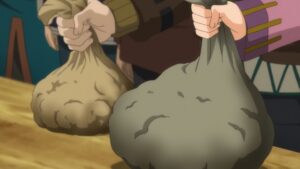
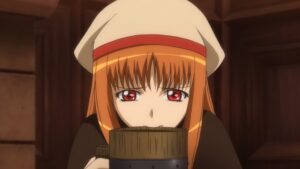
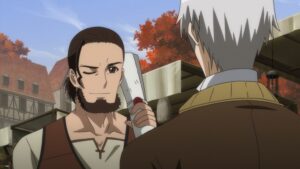

Yay, Haibane Renmei!! It’s one of my favorite anime of all time! I can’t wait to read your entries about it! Which reminds me, I really need to rewatch it some time.
Alas, my poor Escaflowne, losing to a show I’ve dropped twice. Ah well, I’ll continue to have faith, it will win next time!
I’m sorry! The coin has spoken! At this rate though Escaflowne will win next round so shouldnt be to long.